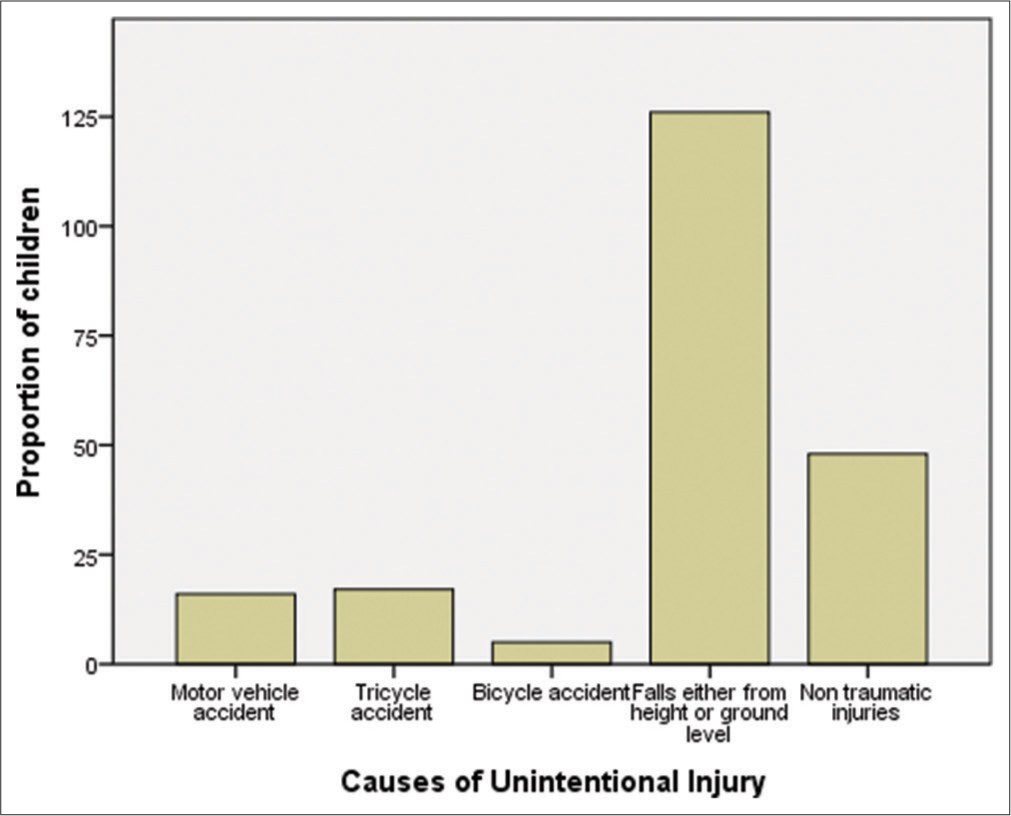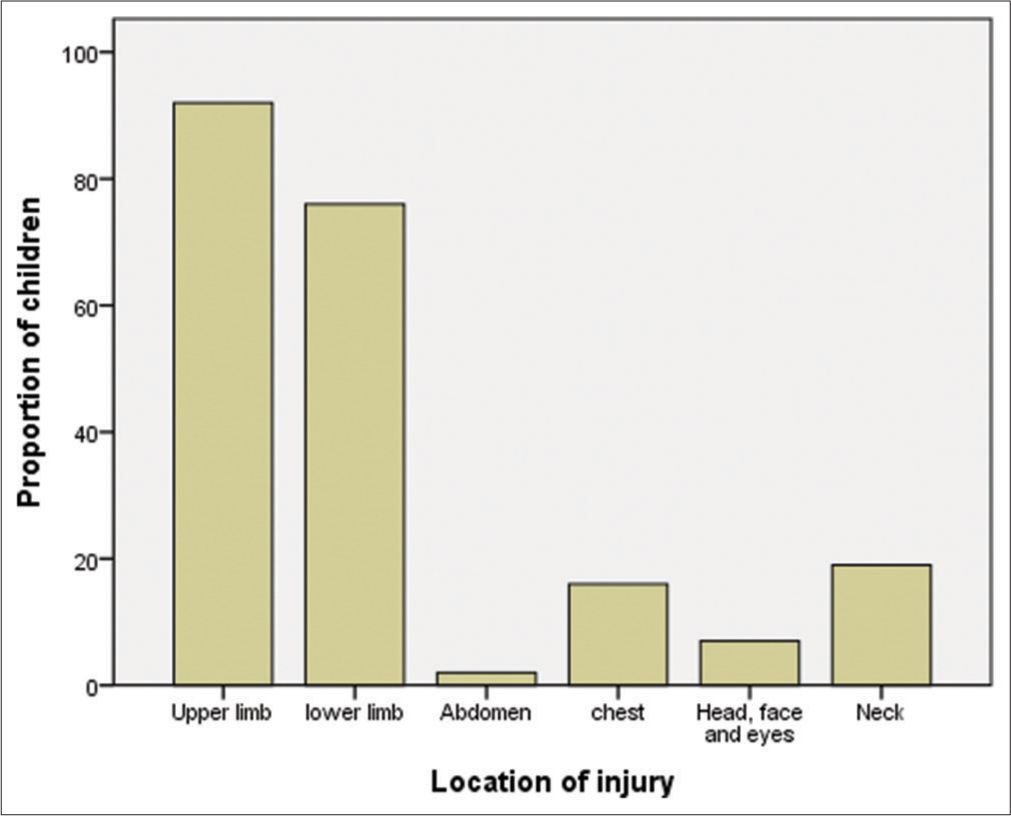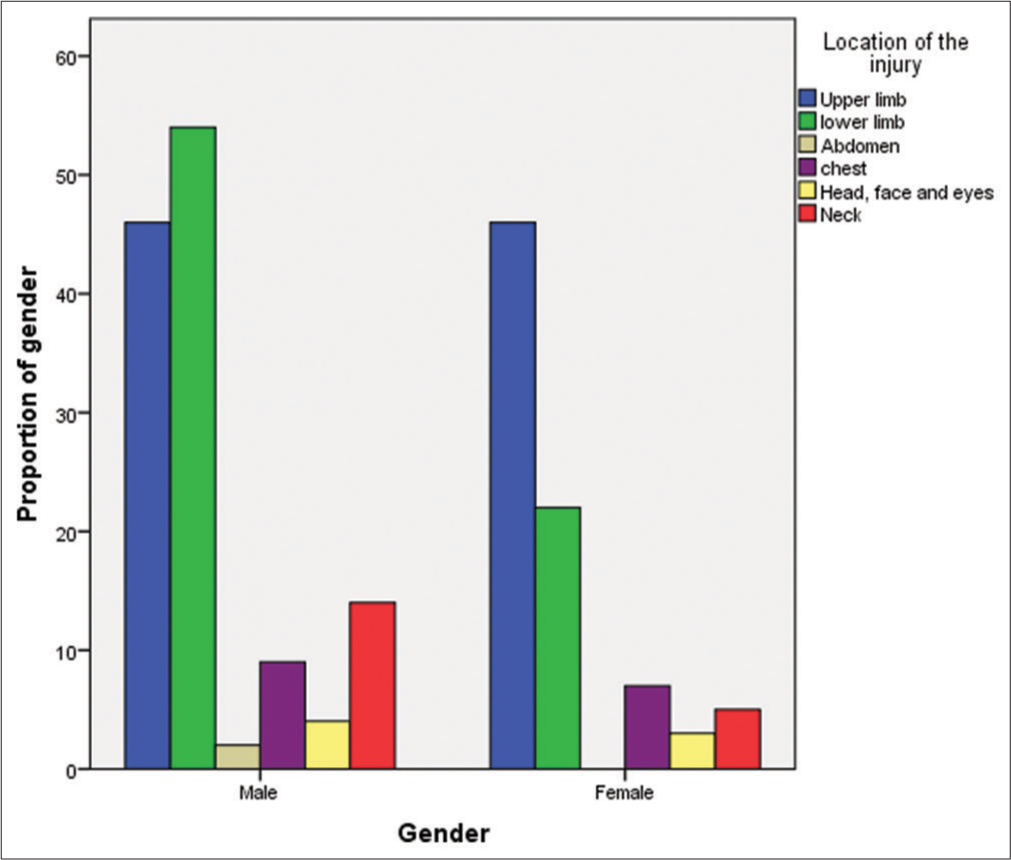Translate this page into:
Pattern of unintentional injuries in children seen in a tertiary hospital in Nigeria
*Corresponding author: Joseph Asuquo, Department of Orthopaedics and Traumatology, University of Calabar, Calabar, Cross River State, Nigeria. itansuq@yahoo.com
-
Received: ,
Accepted: ,
How to cite this article: Asuquo J, Lasebikan OA, Akpet OE, Anisi CO, Asuquo BJ, Agweye PU, et al. Pattern of unintentional injuries in children seen in a tertiary hospital in Nigeria. Karnataka Paediatr J. 2024;39:47-50. doi: 10.25259/KPJ_21_2024
Abstract
Objectives:
Unintentional injuries are bound to occur in children. They are of major public health concern. This study aims to report the type of unintentional injuries and the location of the injuries as seen in a tertiary hospital.
Material and Methods:
This is an ‘ambispective’ hospital-based study lasting for 12 months. This was conducted in the emergency paediatric units of two tertiary hospitals in Southern Nigeria. Every child who reported unintentional injury was included in the study. Structured questionnaires were used to collect the data by trained research assistants. Data were collected and analysed using International Business Machines Statistical Package for the Social Sciences. The results were represented in bar and pie charts, respectively. Ethical approval was given by the Institutional Ethics and Research Committee.
Results:
A total of 212 children were included in the study. Males were the highest (60.8%), and children ≤10 years of age were 64.5%, of which those ≤5 years old were 34.6% respectively. Falls were the main cause of injury in all age groups, constituting 53.9%, followed by ingestion of toxic substances and foreign bodies (29.1%). The upper and lower limbs were mostly affected in 79.2% (n = 168) of the children. Males were commonly injured in the lower limbs.
Conclusion:
Unintentional injuries are commoner in children ≤5 years old; unintentional falls are the most common cause in all age groups and affect mostly the upper and lower limbs.
Keywords
Unintentional injury
Children
Falls
Toxic substance
INTRODUCTION
Unintentional injuries are of major concern worldwide due its attendant morbidity and mortality. Children of all ages are at higher risk of suffering from these injuries.[1] Unintentional injuries are the leading cause of death among children, but the exact proportions vary. There is variation in the causes of unintentional injuries in children from different races, sexes, and geographical locations. In essence, there is a substantial difference whether the regions are developing or developed.[2]
These injuries could be traumatic and non-traumatic. Traumatic injuries are caused by unintentional falls, road traffic injuries, sporting, recreational, fighting, etc. While the non-traumatic injuries are due to unintentional poisoning through ingestion of toxic substances such as insecticides, excessive alcoholic beverages, drug overdose, drowning, and suffocation, the occurrence of these injuries can be influenced by weather conditions and time of the day.[3-5]
Unintentional injuries could lead to emotional trauma and financial burden to families and society at large. These can affect the child’s learning ability, relationships, and unstructured play. Treatment of the unintentionally injured child requires specialised skills and attention to detail due to their physiologic makeup.
Many studies have suggested ways of mitigating the burden of these injuries, such as caregiver supervision, monitoring, use of helmet seatbelt, penalties for traffic violations such as speed limits, and keeping toxic substances out of reach for children.[2,5,6] Some studies have advocated on cause-specific prevention.
In my country, there is a paucity of data on unintentional injuries to build a national surveillance network, and none of these studies talked about the areas of the body commonly affected.[4,6]
This study aims to outline the pattern of unintentional injuries seen in a tertiary hospital and the location of the injury in the body. This will contribute to national data on unintentional injuries in children to help build a national surveillance network.
MATERIAL AND METHODS
This is an ‘ambispective’ study Asuquo et al.[7] which is midway between retrospective and prospective study. The study is a hospital-based study that took place in the emergency paediatric units of two tertiary hospitals in Southern Nigeria. These hospitals are referral centres in their respective regions. The University of Calabar Teaching Hospital (UCTH) is an 800-bed multispeciality hospital located in South-South Nigeria, while the National Orthopaedic Hospital Enugu (NOHE) is located in South-East Nigeria. They both have paediatric orthopaedic units, while the University of Calabar has both paediatric surgical and medical divisions.
The emergency paediatric unit of UCTH and the emergency unit of NOHE were the primary points of call for all unintentional injuries affecting children. An interviewer-administered questionnaire was used to collect information from a sample of caregivers of children with unintentional injuries attending these institutions. Some patient information was extracted from the medical journals of patients who were seen within the study period and included in the study. A total of 212 was the sample size obtained by using Andrew Fisher’s equation[8] for calculating sample size.
The authors and research assistants were used to collect the data from the caregivers and the patient medical journals of those treated and discharged within the study period. The study period spans from February 1, 2023, to January 31, 2024.
The data collected were social demographic characteristics, causes of injury, location of the injury in the body, etc.
The data were analysed using International Business Machines (IBM) Statistical Package for the Social Sciences (IBM Corp., Armonk, NY USA). Descriptive statistics were conducted. The results were presented as percentages and frequencies in pie and bar charts, respectively. Significant inferential statistic was placed at P ≤ 0.05.
Ethical approval was obtained from the Institutional Ethics and Research Committees.
RESULTS
Two hundred and twelve children were included in the study. The highest age group was 1–5 years n = 73 (34.6%), followed by 6–10 years n = 63 (29.9%) and 11–15 years n = 59 (28%) [Figure 1].
There was a high male preponderance of 60.8% [Figure 2].
The causes of unintentional injuries were falls, which constitute 53.9%, followed by non-traumatic injuries 29.1% (this includes ingestion of toxic substances such as insecticides, drowning, suffocation, foreign object ingestion, drug overdose, and alcohol), while all forms of accidents were 17% [Figure 3].
Regarding the location of unintentional injuries, the upper limbs were commonly affected, constituting 43.4% (n = 92), followed by the lower limb with 35.8% (n = 76). The head, face, and eyes were 3.3% (n = 7), the chest was 7.5% (n = 16), the neck was 9% (n = 19) and abdomen was 0.9% (n = 2) [Figure 4].
Regarding gender and location of the injury, males were commonly injured in the lower limb (M = 54 and F = 22), neck (M = 14 and F = 5), chest, abdomen, and head. The lower limb injury was significant, with a P value of 0.045 [Figure 5].

- Distribution of age in groups.

- Sex distribution.

- Causes of unintentional injury.

- Location of unintentional injury.
Children of the pre-school age are more likely to suffer from unintentional falls and non-traumatic injuries [Table 1].
DISCUSSION
Unintentional injuries are bound to occur in children of all ages. The effects of these injuries can be mitigated by preventive measures.
In our series, the majority of the injuries were traumatic in origin, constituting about two-thirds of all injuries seen. This finding was similar to that reported by a Saudi and Chinese study.[2,9] The non-traumatic injuries range from ingestion of insecticides and petrochemicals, especially kerosene, ingestion of foreign bodies, and suffocation, etc. This finding was similar to that reported by a Northern Nigerian study, Saudi and Chinese study. In the Chinese and Saudi studies, drowning and suffocation were among the injuries, but in our setting, these types of injuries are rarely reported, especially if the outcome was fatal.[2,6,9]
In our study, the hand, arm, forearm, legs, and thigh are the most common locations of the injury in the body, followed by the head and neck. Injuries to the head can be fatal in some cases. Most of the reported literature did not take cognizance of the body parts commonly affected.[1,2,9] This is very important in formulating prevention strategies for these age groups, especially cause–specific prevention.
In our study, pre-school-aged children were more prone to unintentional injury than any other age group. This finding was reported by some studies in Nigeria, the USA, and China.[1,2,6] This is due to their inability to assess and predict dangerous situations. They are also prone to unintentional falls and non-traumatic injuries.

- Location of the injury in both genders.
| Age groups (years) of children | Causes of Unintentional injuries | ||
|---|---|---|---|
| All forms of unintentional road traffic crashes | Unintentional Falls | Non-traumatic unintentional injuries | |
| 1–5 | 6 | 44 | 23 |
| 6–10 | 16 | 38 | 9 |
| 11–15 | 15 | 33 | 11 |
| 16–18 | 1 | 10 | 5 |
The male gender was more prone to unintentional injury, whether sporting, accident, or domestic injuries. This finding was reported by several studies.[2,10,11] This is due to adventurous behaviour, and they engage in risky activities. Some studies have suggested that female children are less likely to be injured as they get older.[2]
Our study reveals that males are more commonly injured in the lower limb as compared to female children.
There are several preventive measures reported in the literature but we think that they can only reduce the occurrence and mitigate the effects of unintentional injuries.
The limitation of this study is that it is a hospital-based study and the strength is that it shows the location of these injuries.
CONCLUSION
Unintentional injuries commonly affect preschool aged children involving the upper and lower limbs mostly. Injuries result from unintentional falls mostly, and males are commonly injured in the lower limbs.
Preventive measures can only mitigate the effects of these injuries.
Ethical approval
The Health Research and Ethical Committee of University of Calabar Teaching Hospital, Calabar assigned a Protocol number for this study UCTH/HREC/33/408 on 11 January 2023.
Declaration of patient consent
The authors certify that they have obtained all appropriate patient consent.
Conflicts of interest
There are no conflicts of interest.
Use of artificial intelligence (AI)-assisted technology for manuscript preparation
The authors confirm that there was no use of artificial intelligence (AI)-assisted technology for assisting in the writing or editing of the manuscript, and no images were manipulated using AI.
Financial support and sponsorship
Nil.
References
- Reducing the global burden of childhood unintentional injuries. Arch Dis Child. 2014;99:62-9.
- [CrossRef] [PubMed] [Google Scholar]
- Causes and characteristics of children unintentional injuries in emergency department and its implications for prevention. Front Public Health. 2021;9:669125.
- [CrossRef] [PubMed] [Google Scholar]
- Falls in children birth to 5 years: Different mechanisms lead to different injuries. J Trauma Acute Care Surg. 2012;73:S254-7.
- [CrossRef] [PubMed] [Google Scholar]
- Does weather condition influence the epidemiology of paediatric orthopaedic trauma in Southern Nigeria? AJORR. 2020;3:22-9.
- [Google Scholar]
- Global childhood unintentional injury surveillance in four cities in developing countries: A pilot study. Bull World Health Organ. 2009;87:345-52.
- [CrossRef] [PubMed] [Google Scholar]
- Prevalence and pattern of unintentional domestic accidents and trauma amongst children attending public hospitals in Kano, Nigeria. Sahel Med J. 2018;21:6-12.
- [CrossRef] [Google Scholar]
- Early re-operation in patient with spinal metastases. J Spine Neurosurgery. 2016;5:1-4.
- [Google Scholar]
- The pattern of unintentional injuries and poisoning among children admitted to King Abdulaziz medical city, Jeddah, from 2014 to 2018 in Saudi Arabia: A cross-sectional study. Cureus. 2022;14:e30484.
- [CrossRef] [Google Scholar]
- Avulsion fracture of the tibial tubercle in a child with testicular feminization syndrome. J Musculoskelet Surg Res. 2023;7:206-9.
- [CrossRef] [Google Scholar]
- Epidemiology of unintentional child injuries in the Makwanpur district of Nepal: A household survey. Int J Environ Res Pub Health. 2015;12:15118-28.
- [CrossRef] [PubMed] [Google Scholar]







